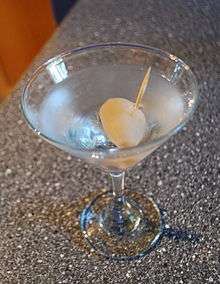Gibson (cocktail)
 | |
| Type | Cocktail |
|---|---|
| Primary alcohol by volume | |
| Served | stirred |
| Standard garnish | |
| Standard drinkware | |
| Commonly used ingredients | |
| Preparation | *Stir well in a shaker with ice, then strain into a chilled martini glass. Garnish and serve |
The Gibson is a mixed drink made with gin and vermouth, and often garnished with a pickled onion. The oldest published recipe for the Gibson is found in the 1908 book, The World's Drinks And How To Mix Them by William Boothby.

Other pre-prohibition recipes for the Gibson exist. They all omit bitters and none of them garnish with an onion. Some garnish with citrus twists. Others use no garniture at all. No known recipe for the Gibson garnishes with an onion before 1922. Some sources persist in using other garnishment than the onion into the 1930s and beyond, but still none use bitters.
The drink is traditionally made with gin, but the vodka Gibson is also common.
History
The exact origin of the Gibson is unclear, with numerous popular tales and theories about its genesis. According to one popular theory Charles Dana Gibson is responsible for the creation of the Gibson, when he supposedly challenged Charley Connolly, the bartender of the Players Club in New York City, to improve upon the martini's recipe, so Connolly simply substituted an onion for the olive and named the drink after the patron.
Gibson could have been the Californian popular onion farmer as seen in the publication Hutchings' illustrated California magazine: Volume 1 (p. 194) by James Mason Hutchings in 1857:
ONION VALLEY. During the winter of 1852 and '53, snow fell in Onion Yalley to the depth of twenty-five feet, ... Even the towns of Gibson- ville, Seventy-Six, Pine Grove, Whiskey Diggings, and several others, did their trading here.
Other stories involve different Gibsons, such as an apocryphal American diplomat who served in Europe during Prohibition. Although he was a teetotaller, he often had to attend receptions where cocktails were served. To avoid an awkward situation, Gibson would ask the staff to fill his martini glass with cold water and garnish it with a small onion so that he could pick it out among the gin drinks. A similar story postulates a savvy investment banker named Gibson, who would take his clients out for the proverbial three-martini business lunches. He purportedly had the bartender serve him cold water, permitting him to remain sober while his clients became intoxicated; the cocktail onion garnish served to distinguish his beverage from those of his clients.
Another version now considered more probable of the origin story given by Charles McCabe of the San Francisco Chronicle states it is from San Francisco. In 1968 McCabe interviewed Allan P. Gibson (1923–2005) and included the story in his Dec. 9, 1968 column, as well as in his book The Good Man's Weakness. A.P. Gibson remembered that when he was a boy, his great-uncle, prominent San Francisco businessman Walter D. K. Gibson (1864–1938), was said to have created it at the Bohemian Club in the 1890s. Charles Clegg, when asked about it by Herb Caen, also said it was from San Francisco.[1] Eric Felton, writing in the Wall Street Journal, May 30, 2009 "A Thoroughly Western Cocktail" considers this version correct; he cites Ward Thompson, a Bohemian Club member whose mention of it in 1898 is the first recorded in print. Although bartenders' guides sometimes gave the recipe as 50/50 gin and vermouth, Gibsons in the early days were much drier than other martinis.
A third version, supported by Kazuo Uyeda in "Cocktail Techniques", states that Gibsons started as very dry martinis garnished with a cocktail onion to distinguish them from traditional martinis, but as the fondness for drier martinis became popular the onion became the only difference.
There is no direct evidence that Charles Dana, or any other Gibson, created the drink. But, Charles Dana Gibson was certainly the artist who created the 'Gibson girl' illustrations—popular from the 1890s through about the time of the first world war. It has been suggested that the Gibson girl was the first widespread visual standard for beauty in American women. Given that ubiquity and popularity, it is also very possible that the drink was simply named after the Gibson girl. This possibility is, perhaps, less appealing to some who prefer to associate famous drinks with notable historic persons.
See also
References
- ↑ "One Man's San Francisco", Chronicle Books, p.155, Herb Caen